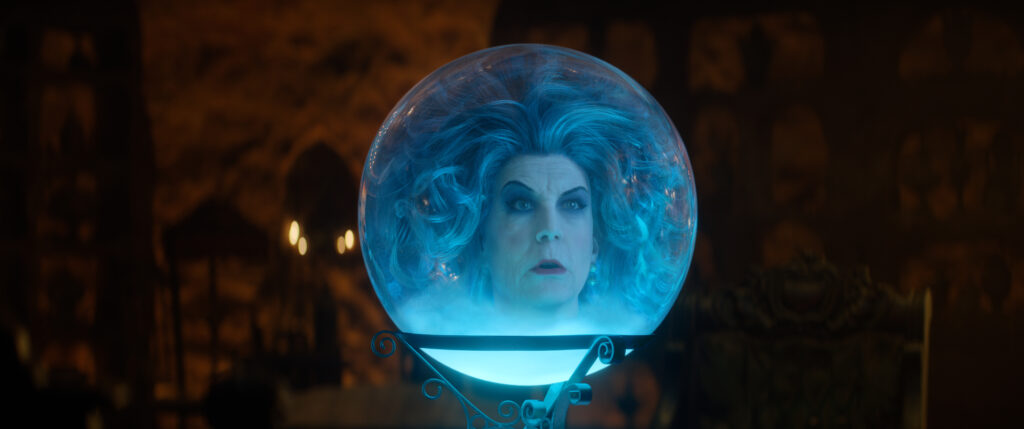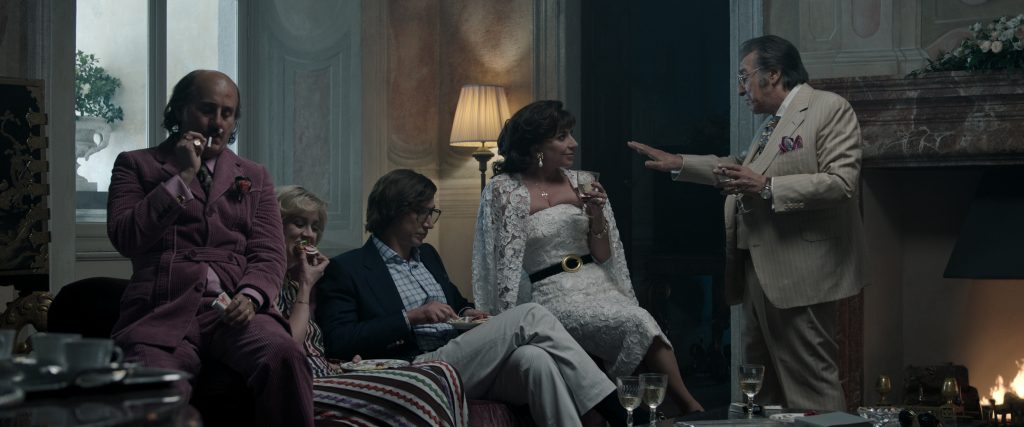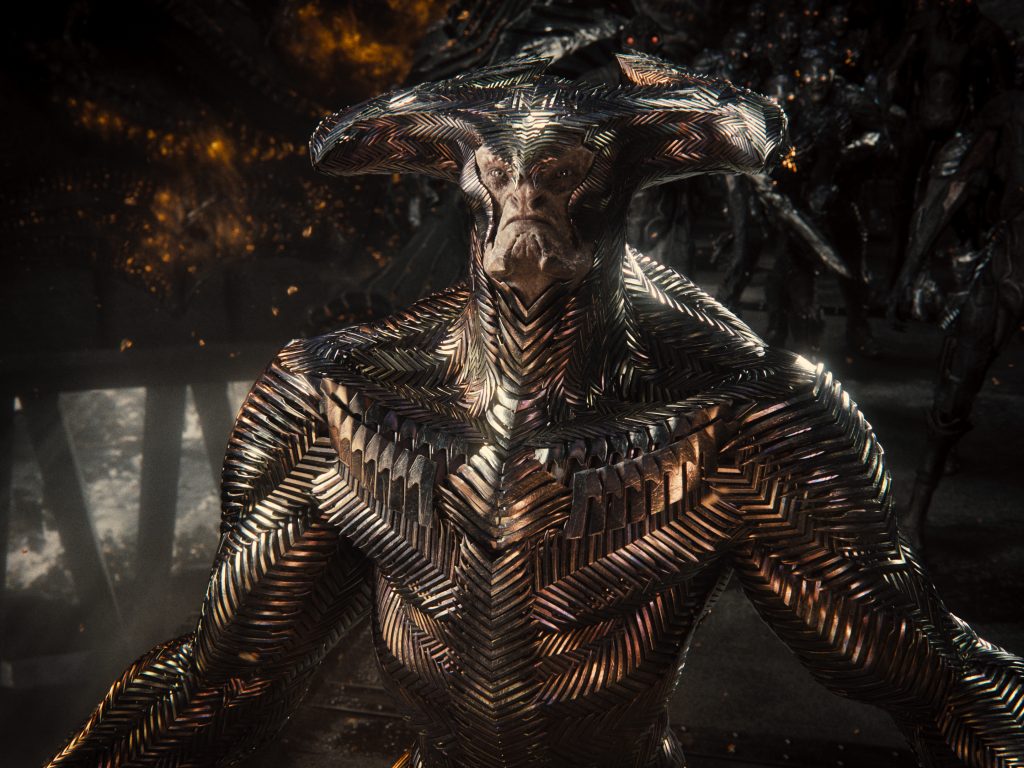July 25, 2023
by Carla Hay

Directed by Justin Simien
Culture Representation: Taking place in New Orleans, the comedy horror film “Haunted Mansion” (based on the Disney amusement park ride) features an African American and white cast of characters representing the working-class, middle-class and wealthy.
Culture Clash: A single mother and her son move into a haunted mansion and enlist several people (including a ghost tour guide, a history professor, a priest and a medium) to help get rid of the evil spirit haunting the house.
Culture Audience: “Haunted Mansion” will appeal primarily to people who are fans of the movie’s headliners, the Disney amusement park ride on which the movie is based, and mildly interesting but underwhelming horror comedies.

As a horror comedy, “Haunted Mansion” is built on a sinkhole of mishandled opportunities. The jokes are weak. The action is underwhelming. This stale reboot isn’t a complete waste of time, but it’s disappointing, considering the talented people involved. But it’s not too surprising, considering there’s nothing much that’s truly innovative in this lazy “Haunted Mansion” retread that has a lot of annoying product placement mentions incorporated into the mediocre dialogue.
Directed by Justin Simien and written by Katie Dippold, “Haunted Mansion” is a reboot of the 2003 comedy film “The Haunted Mansion” (starring Eddie Murphy), which was also a not-very-funny movie version of Disney’s iconic Haunted Mansion amusement park ride. The 2023 “Haunted Mansion” movie could have done so many unique and fantastic things for the story, but instead took the most obvious and boring route possible: A family moves into a haunted mansion, experiences terror from an evil spirit, and then must find an artifact previously owned by the ghost, in order to cast the spell that will permanently send the evil spirit away.
It takes an awfully long time for “Haunted Mansion” (which clocks in at a little more than two hours) for the characters to get to the revelation of how to get rid of the ghost. The “adventure” part of the story doesn’t really start until the movie is more than halfway over. Until then, “Haunted Mansion” is just a series of scenes where characters are introduced, and then they babble and argue about different ways to find out the secret of this haunted mansion. Just because certain characters get a lot of screen time, doesn’t mean that viewers will really learn a lot about these characters during the course of the movie.
“Haunted Mansion” was filmed on location in New Orleans, where the story takes place. Although the 2023 “Haunted Mansion” movie has an ensemble cast, the story’s chief protagonist is a former astrophysicist named Ben Matthias (played by LaKeith Stanfield), who now works as a “ghost tour” guide in New Orleans. Ben’s wife Alyssa (played by Charity Jordan), who died in a car accident, used to have this job. Near the beginning of the movie, a flashback shows that Alyssa and Ben met at a New Year’s Eve party. During their flirtatious conversation, Alyssa told him that she was a ghost tour guide, and she invited him on a tour, even though Ben says he doesn’t believe in ghosts.
Ben and Alyssa’s marriage is never shown in the movie, except for a few fleeting and superficial scenes of them cuddling as spouses. The problem with this void in the story is that a huge part of the plot hinges on Ben’s grief over Alyssa’s death. Viewers only get a quick “drive-by” version of the marriage. And therefore, there’s not much context given for Ben’s grief, since he barely talks about the marriage in the movie. Stanfield’s performance as Ben is perfectly adequate (Ben has a big emotional scene toward the end of the movie), but Stanfield also looks bored for a great deal of the movie.
Ben gets mixed up in the haunted house hijinks when he gets a visit from a wisecracking priest named Father Kent (played by Owen Wilson), who tells Ben that someone wants to hire Ben for a paranormal investigation of a mansion that is believed to be haunted. Ben immediately says no, but Ben changes his mind when he finds out that he’ll be paid $1,000. Ben takes the job because he desperately needs the money. Ben also has a “paranormal” camera that he invented because he thinks this camera can take photos of ghosts.
The person whose mansion needs to be investigated for paranormal activity is a doctor named Gabbie (played by Rosario Dawson, in a capable but bland performance), who has moved from New York to New Orleans with her 9-year-old son Travis (played by Chase W. Dillon), who is intelligent, sensitive and a bit nerdy. Gabbie’s deceased mother used to own this mansion, which Gabbie and Travis found out was haunted on the first night that they both stayed there as residents. And where is Travis’ father? That information is revealed later in the story.
To Ben’s surprise, his paranormal camera works and takes a photo of the ghost at the mansion. An investigation reveals that the mansion, which was built in 1888, used to be owned by a wealthy man named William Gracey (played by J.R. Adduci), who bought the house for his ailing wife Eleanor Gracey (played by Erika Coleman). A psychic medium named Madame Leota (played by Jamie Lee Curtis) and an affluent real-estate heir named Alistair Crump (played by Jared Leto), who both lived in New Orleans during that era, also factor into the story.
Alistair’s story is an obvious spoof commentary of Donald Trump’s story. It should come as no surprise to many viewers which character is the story’s villain. Leto appears in “Haunted Mansion” as a CGI ghost that looks like a tuxedo-wearing version of the Cryptkeeper from “Tales from the Crypt.” The Madame Leota character is trapped in a crystal ball, so only Madame Leota’s talking head is shown for most of Madame Leota’s screen time. It’s all very ho-hum horror.
Joining the investigation are a loudmouthed psychic/medium named Harriet (played by Tiffany Haddish) and a cranky professor of history named Bruce Davis (played by Danny DeVito), who is the most oddly placed character in the movie. Due to sloppy film editing and a jumbled screenplay, Bruce randomly shows up here and there and doesn’t do much but say things that often offend the other characters. There’s a scene where Bruce spends the night at the haunted mansion, with no good explanation for why he’s sleeping there.
“Haunted Mansion” is very deficient in character development. Almost all of the characters don’t have fully formed personalities, but are only playing “types.” Harriet sure likes to talk a lot (she’s the character with the most “product placement” lines), but by the end of the movie, there’s nothing interesting that has been revealed about Harriet. Travis is supposedly treated like an outcast by his student peers at school, based on what he tells people, but the movie never shows Travis in school. Father Kent has a secret that is so obvious and not surprising at all when it’s revealed. Ben is the only “Haunted Mansion” character who has something resembling a backstory, but it’s shown in fleeting clips.
As an example of how much the 2023 “Haunted Mansion” movie squanders the chance to bring some memorable flair to the story, the movie severely under-uses a sassy character named Vic (played by Dan Levy), who is a tour guide for the Crump mansion, which has been declared a historic landmark. Vic is in the movie for less than 10 minutes. There’s a scene where Vic is entertaining guests at the Crump mansion with a sing-along, but everything is only heard (not seen) in another room, for a brief moment that last less than 30 seconds.
It’s incredibly mind-boggling and foolish to waste the talents of Emmy-winning “Schitt’s Creek” star Levy by barely featuring him in the movie. The “Haunted Mansion” audience is teased with the fact that Levy’s Vic character is a music performer, but the movie never shows Vic actually being a music performer. Also very under-used is Winona Ryder, who has a quick cameo as another Crump mansion tour guide named Pat. Ryder’s screen time in “Haunted Mansion” is less than three minutes of uttering forgettable dialogue.
The blame for these bad decisions lies mostly with director Simien, whose previous films “Dear White People” and “Bad Hair” (he wrote and directed both movies) had elements of sharp satire that are absent from “Haunted Mansion,” which is admittedly a family-oriented movie. But even if “Haunted Mansion” is supposed to be a tame horror comedy that shouldn’t be too scary or too edgy for underage kids, Simien seems to have been worn down by the Disney corporate machine, to the point where “Haunted Mansion” has no spark or creative vision. Simien’s real-life amusing personality does not shine through in this generically directed movie. And that’s a shame, because the 2023 “Haunted Mansion” movie had the opportunity to be an instant classic.
Compared to the 2003 “Haunted Mansion” movie, the 2023 “Haunted Mansion” mansion movie benefits from better technology for more advanced visual effects. However, in the 20 years between the releases of the two “Haunted Mansion” movies, Disney has not offered a reboot with a better story than its predecessor. The 2023 “Haunted Mansion” film exists as a hollow promotional tool for the Disney amusement park ride and the companies that paid for the movie’s awkward and shameless product placements.
Walt Disney Pictures will released “Haunted Mansion” in U.S. cinemas on July 28, 2023.












